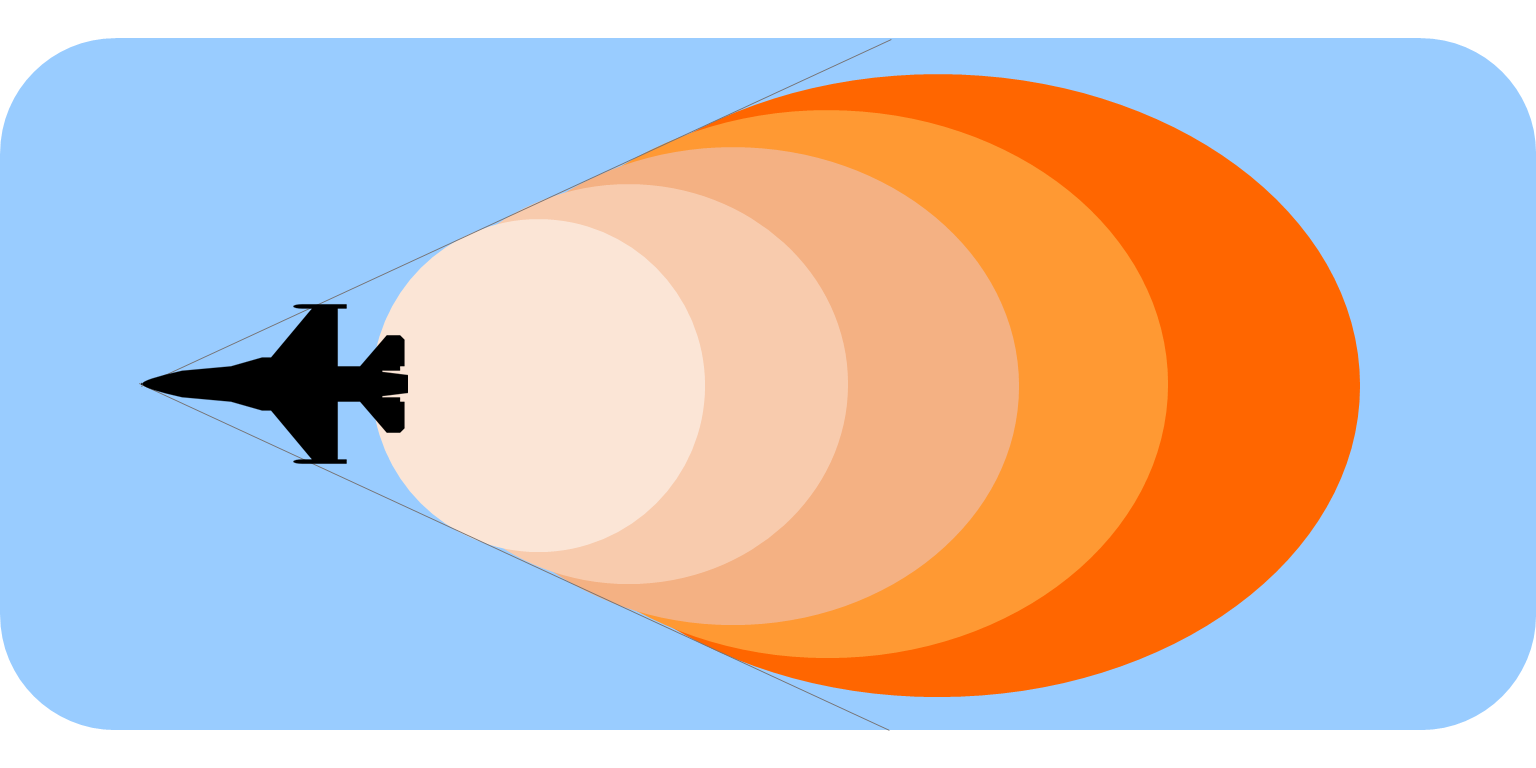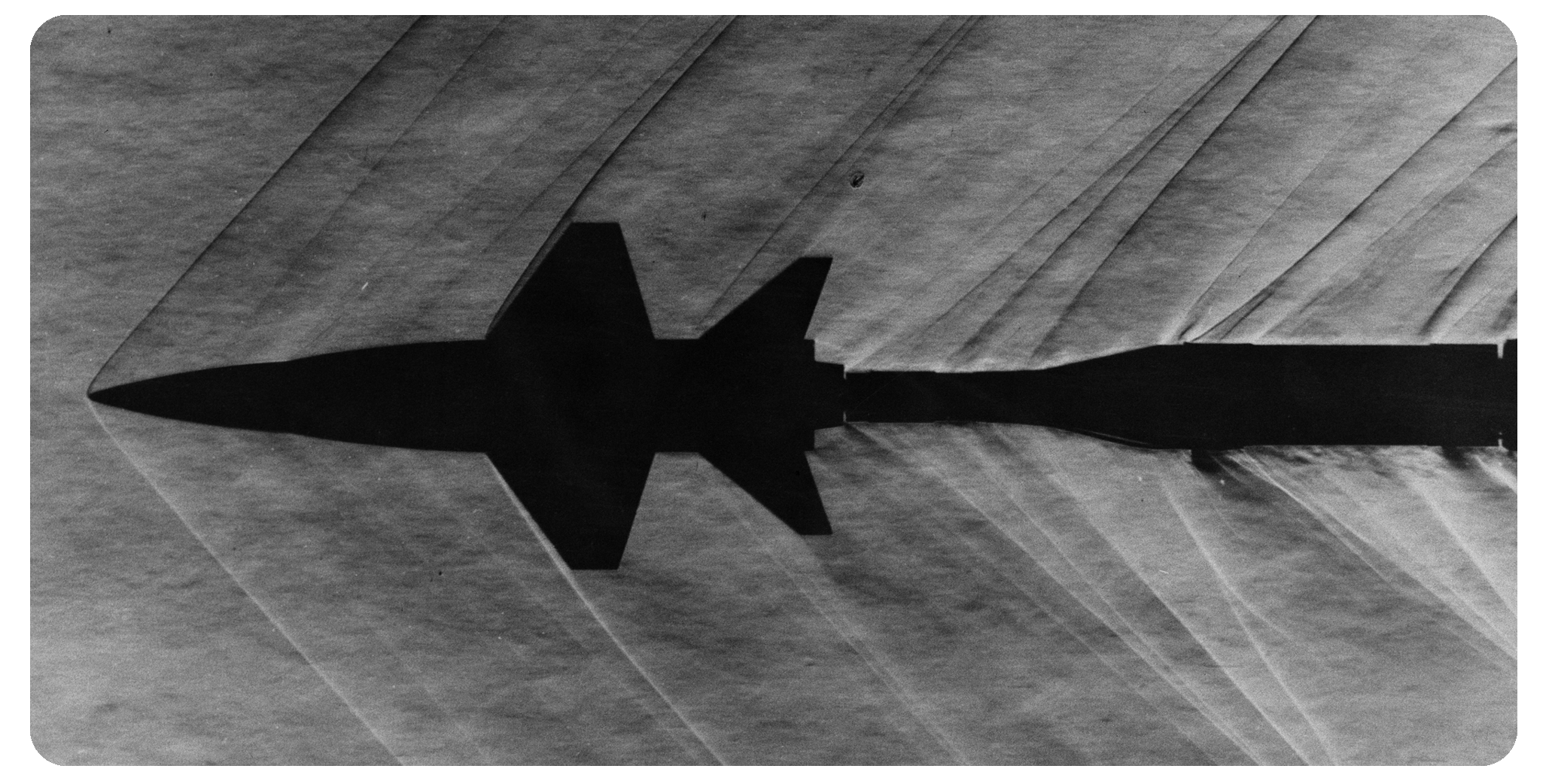V - High Speed Flows #
Things Get Hot When You Get Going Fast #

SpaceX Falcon Heavy. Photo courtesy of Pauline Acalin.
Introductory Thoughts #
Many of the concepts explored on this site fall within the realm of ‘low speed aerodynamics’. High speed aerodynamics (~ 300mph/480kph+) begins to operate within a different physics regime, resulting in the design considerations diverging from the low speed case.
Pressure Waves #
The first article (I - Form) discusses that air reacts early to the presence of a vehicle by flowing around it (and not at it). The second article (II - Energy) established that this is due to the static pressure field projecting the influence of the body past it’s perimeter, allowing the flow to ‘sense’ the presence of the body well ahead of it.
This static pressure field is the result of pressure waves continuously emanated outwards by the surface.
At low speeds, the pressure waves projected by the body, and therefore the static pressure field, move outwards uniformly at the speed of sound.

As the vehicle picks up even more speed, the pressure waves continue to move outward uniformly. But due to the objects forward velocity, the wave fronts begin ‘stacking’ ahead of the object. This means that the static pressure field doesn’t project as far forward of the vehicle, giving the flow less time to react to the presence of the vehicle.
Below ~ 200mph, this stacking isn’t enough to have any appreciable effects on the flow behavior. The static pressure field still extends reasonably far forward of the vehicle, so the flow still has sufficient time to react to the presence of the body.

However, with ever increasing velocity, the flow ‘runs into’ the pressure waves at an increasingly faster rate. This causes the flow to be compressed. This compression effects the fluid temperature, velocity and pressure to a significant degree.
Right on the cusp of breaking the sound barrier, the pressure waves stack up in front of the object and significantly compress the flow.

When a vehicle goes supersonic, it outruns the outward propagation of the static pressure waves. In supersonic flow, the flow no longer has an indication of the approaching vehicle.
At this point, the fluid flows at the object, and can’t flow around it until the very last second. The first contact causes a sudden change in direction, called a shock. This is visualized as a shockwave.

The Shockwave #
Past supersonic speeds, the primary design concern is management of shockwaves. This carries with it a much different set of design best practices than low speed aerodynamics. Shockwaves cause vibrations & extreme heating that can tear an object apart. Additionally, shockwaves should not be ingested into the engine intake, as catastrophic failure could result.
For drag reduction the shock has to be made as weak as possible, which necessitates the change in direction be as small as possible. This can best be achieved by a slender, pointy tip, as seen on many military aircraft that fly at supersonic speeds.

X-15 model in a supersonic wind tunnel. Photo courtesy of NASA.
Really Fast #
In hypersonic flow (Mach > 5) a blunt nose might again be preferable if the nose can resist aerodynamic heating. A pointed tip produces an attached shock which heats the tip to something close to the stagnation temperature of the flow. A blunt nose, however, causes a separated shock. This creates more drag and a higher amount of heat overall, but allows to spread this heat over a larger area and dump most of it into the air, producing lower peak loads. The Space Shuttle had such a blunt nose, since drag minimization is not a priority for a re-entry vehicle.
Past an even higher threshold, one needs to be concerned with the ionization of the gas, which results from the extreme temperature and pressure acting to break down the molecular bonds of the air.

Ionzed gases surrounding a space shuttle model during simulated reentry. Photo courtesy of NASA.
Upper Atmosphere #
Vehicles that move very fast also typically fly up very high. In the upper atmosphere, individual air particles are so widely spaced apart that the fluid can’t be treated as a continuous membrane. Each molecule has to be considered individually.
| Elevation | Mean Free Path |
|---|---|
| 0 km (sea level) | .0001mm |
| 20km (U2 flight) | .001mm |
| 50km (balloons) | .1mm |
| 150km (low orbit) | 1000mm (1m) |
The mean free path is the distance the average molecule travels before colliding with another molecule.
This has ramifications in the aerodynamic design of something like a low earth orbit satellite, where the air (there isn’t much in LEO, but there is some) has to be treated as individual particles.
Concluding Thoughts #
The fundamental principles between low & high speed aerodynamics are the same, but the applications are entirely different. This is why the aerodynamic design of high speed objects like missiles, rockets and military aircraft diverge so significantly from objects in the low speed aerodynamics realm.
For questions or clarifications on this, or any other article, reach out to Nav@WorksAero.com.